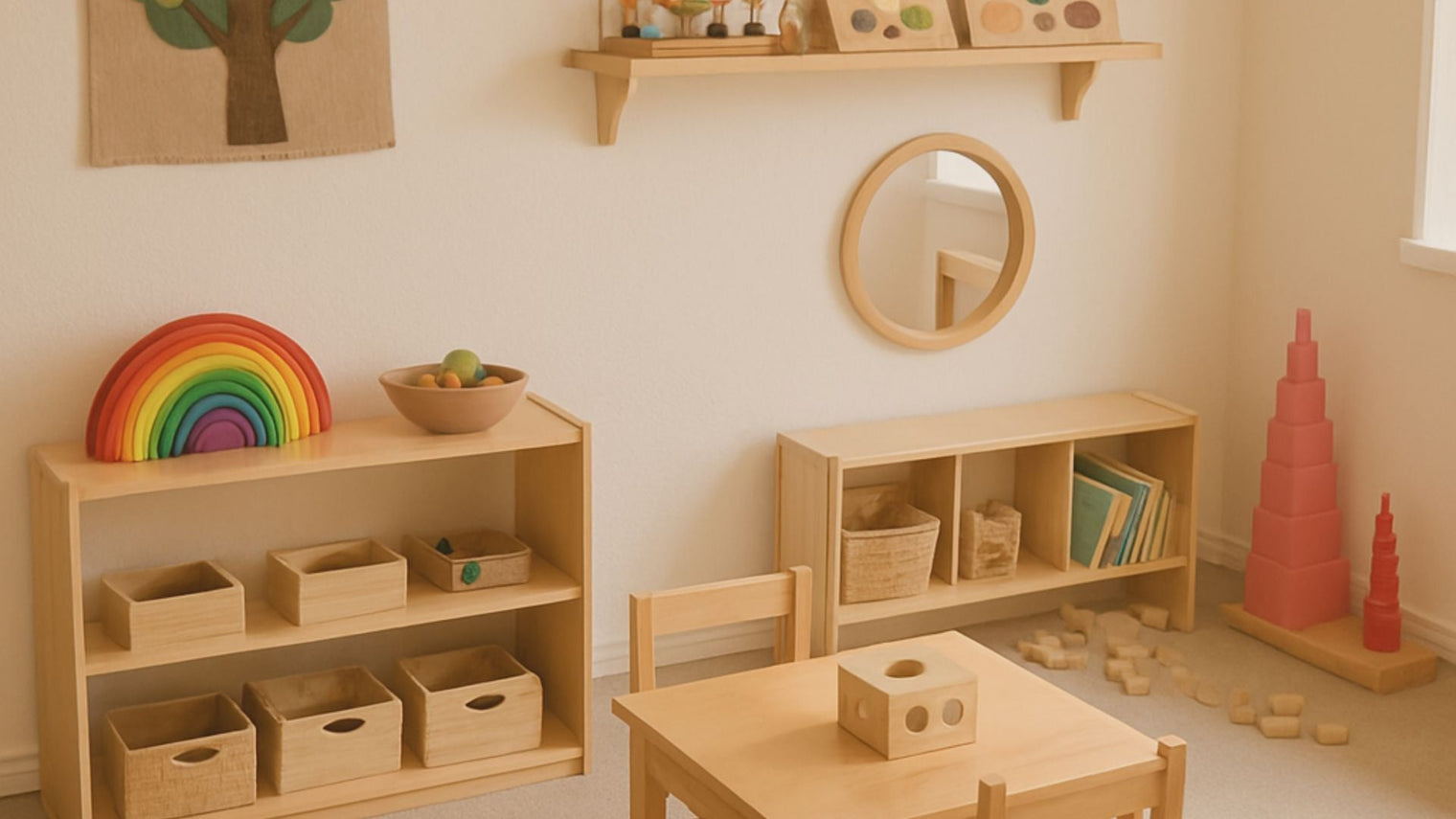Creating a calm, inspiring space for your child to play and learn starts with how you organize their environment.
In Montessori philosophy, a child’s surroundings play a big role in shaping their independence, confidence, and curiosity.
One of the simplest yet most effective ways to support this is through open shelving — a thoughtful, child-friendly setup that encourages exploration and self-guided play.
At Dannico Woodworks, we believe that great design supports great learning.
Our handcrafted Montessori Bookshelf Collection is built with this very idea in mind — to help parents create beautiful, functional spaces that nurture independence while maintaining order and calm.
If you’ve ever wondered how to set up Montessori toys on open shelving effectively, this guide walks you through everything you need to know — from layout and rotation to practical organization tips that actually work.

This child-centered approach emphasizes independence, freedom within limits, and respect for a child's natural psychological development.
Montessori environments are carefully prepared to allow children to explore and learn at their own pace.
The Role of Open Shelving
Open shelving plays a crucial role in Montessori environments. It allows children to see all their toys and materials at a glance, fostering decision-making and independence.
When toys are displayed neatly and within reach, children can easily choose what they want to play with and return it when they're done. This accessibility encourages responsibility and self-discipline.
Choosing the Right Shelving
When selecting shelving for your Montessori play area, consider both aesthetics and functionality.
Look for shelves that are sturdy, safe, and at a height accessible to your child. Natural wood shelves are a popular choice due to their durability and timeless appeal.
The number of shelves will depend on the space available and the number of toys you wish to display.
Safety First
Ensure the shelves are securely anchored to the wall to prevent tipping. Safety is paramount in any child's play area, and proper installation is non-negotiable.
Additionally, check for sharp edges or corners that could pose a risk to your child.
Organizing Montessori Toys

Categorize the Toys
Start by categorizing the toys into groups. Common categories include sensory toys, puzzles, building blocks, art supplies, and practical life tools.
Grouping toys by type makes it easier for children to find what they need and encourages them to engage in diverse activities.
Limit the Number of Toys
In a Montessori setting, less is more. Limiting the number of toys on display prevents overstimulation and promotes focused play.
Rotate toys periodically to keep the environment fresh and exciting. This also gives children the opportunity to rediscover forgotten toys.
Use Baskets and Trays
Baskets and trays are invaluable organizational tools. They not only keep toys contained but also add an element of order and aesthetics to the shelves.
Choose baskets made of natural materials like wicker or cloth to maintain a harmonious look.
Label the Shelves
Consider labeling the shelves with pictures or words to help your child identify where each toy belongs.
This reinforces language development and aids in tidying up. For younger children, picture labels are especially helpful.
Creating an Inviting Play Space
Beyond organization, the overall ambiance of the play space matters. Here are some tips to make the area inviting and conducive to learning:
Incorporate Natural Elements
Bring elements of nature into the playroom. This could be as simple as a small potted plant or a nature-themed wall decal. Nature has a calming effect and inspires curiosity.
Use Soft, Neutral Colors
Opt for a color palette that is soothing and not overly stimulating. Soft, neutral colors create a peaceful environment that allows the toys to stand out without overwhelming the senses.
Ensure Adequate Lighting
Good lighting is essential for any play space. Natural light is ideal, so position shelves near windows if possible. If natural light is limited, consider warm, adjustable lighting to mimic daylight conditions.
Encouraging Independence and Responsibility
The ultimate goal of organizing Montessori toys is to encourage independence and responsibility.
When children have the freedom to choose their activities and learn to care for their environment, they develop essential life skills.
Teach and Model Organization
Take the time to teach your child how to organize and care for their toys. Model the behavior by demonstrating how to return toys to their designated spots. Encourage them to participate in tidying up as part of their daily routine.
Celebrate Effort and Progress
Acknowledge your child's efforts in keeping their play space organized. Positive reinforcement boosts their confidence and motivates them to maintain order.
Remember, the journey towards independence is gradual, and celebrating small achievements is key.
FAQs
How often should I rotate Montessori toys?
Every 1–2 weeks is a good rhythm, but watch your child for cues. If they lose interest in certain items or seem bored, it’s time to refresh the selection.
Can I include non-Montessori toys on open shelving?
Yes — as long as they promote hands-on, imaginative, or skill-building play. The key is intentionality rather than strict adherence to materials.
How do I encourage my child to put toys back?
Model the behavior yourself and keep the setup consistent. When everything has a visible, accessible place, cleanup becomes second nature.
What’s the best age to start Montessori shelving?
You can begin as early as 6–9 months, starting with a single low shelf displaying a few simple items. As your child grows, adjust the setup to include more variety and complexity.
Bringing It All Together
Organizing Montessori toys on open shelving isn’t just about tidiness — it’s about creating an environment that respects your child’s independence and curiosity.
When every item has a purpose, and every choice is accessible, children naturally take the lead in their own learning.
At Dannico Woodworks, we design furniture that supports this vision. Our handcrafted Montessori Bookshelf Collection blends functionality with timeless design — giving parents peace of mind and children the freedom to explore.
Visit Dannico Woodworks to find the perfect shelf for your child’s space, and start creating a room that truly grows with them.
Final Thought:
When your child walks up to their neatly arranged shelf and chooses a toy with confidence, what do you think they’re really learning — and how can you design their space to keep that sense of independence growing every day?


